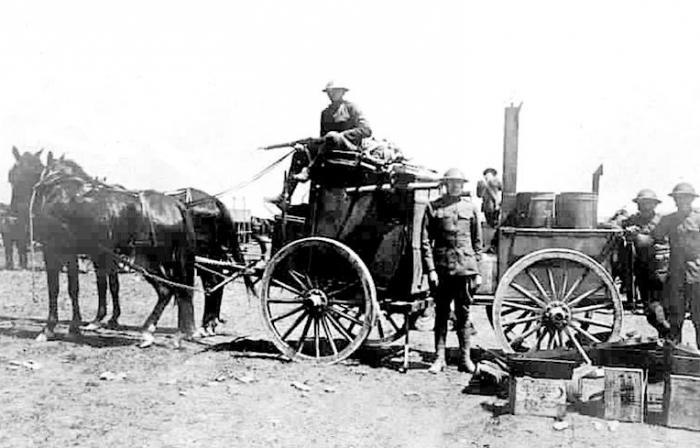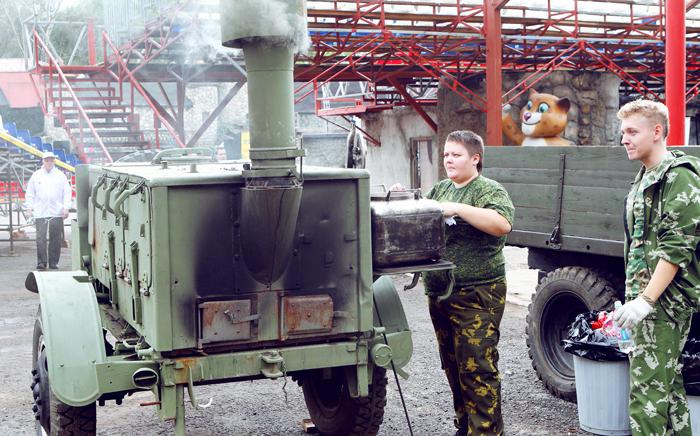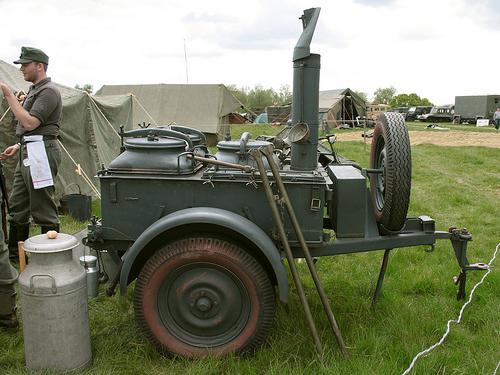What is a field kitchen, is best known for professional military personnel and those who honestly "hacked" military service. However, people far from the army have a good idea of it - at least from films about the Great Patriotic War. And even in peacetime, outside the army, the field kitchen continues to be beneficial: it is used in "wild" (scout, forest - call it whatever) camps for children, in hiking trips, geological and archaeological expeditions, and at public events. At the same time, such a useful invention was born not so long ago.
How soldiers used to eat
As early as the 18th century, service people fed themselves. That is, the state was not at all bothered by the problem of feeding the army. The soldiers were supposed to buy food with their money from residents at the place of service. The situation changed only during the reign of Peter I, who for five years managed to establish the supply of his army with food, calculating the necessary food standards for the soldier. The most interesting thing is that the servants were still obliged to pay for food, however, it was delivered to them directly to the unit, and enough (even in excess) money was given to it over and above the salary. Moreover, suppliers were forbidden to “raise” prices; they were strictly controlled, a ceiling was installed, above which it was forbidden to take.

The military field kitchen of that time was a boiler transported by a convoy. They were delivered to the place of deployment in the first place, and to the approach of the troops lunch (or dinner) was already waiting for the campers. However, cooking in advance or storing food was not possible - the boilers were made of copper, and the food in them quickly disappeared.
The prototype of modern field kitchens
A peculiar coup in the soldiers ’nutrition was made by Colonel Turchanovich during the Russo-Japanese War. The first army field kitchen of his authorship was called in those days a universal portable hearth and really made life easier for employees. Four hours - and a quarter of a thousand people are provided with a three-course dinner (if tea is considered a separate dish). By World War I, almost all European armies had acquired such a useful invention. The field kitchen of Turchanovich’s ideas consisted of two boilers mounted on a wagon equipped with an opportunity to be handed back, and a separately movable box transporting related kitchen utensils and food. The furnaces at the boilers were autonomous; one was intended for cooking the first, the second - porridge and the like, in addition, it was equipped with a special coating ("oil jacket"), thanks to which the second dishes never burned.
The most sought after camping cuisine
Undoubtedly, time and subsequent craftsmen made their adjustments to the original design. The KP 125 field kitchen is considered to be one of the most popular at this stage. In it you can not only cook, as in the invention of Turchanovich, but also transport ready-made food - the boilers are made of stainless steel, and there are already three of them. There is enough volume to feed more than a hundred people (however, the numbers in the title indicate this: field kitchen KP 125 - which means that there will be enough food for so many). It is also convenient in transportation, since it clings in the form of a trailer to any sufficiently powerful transport.
If you want more
A good alternative to this device can be a field kitchen 130. Although it does not exceed the previous one in the number of “fed” ones, there are already 4 boilers. Of these, 2 are for the first, and one is for boiling water used to make tea, coffee and fruit drinks (well and for domestic needs too). At the same time, it also includes an oven, and it can work on wood, and on diesel fuel, and on kerosene, and on gas, and on coal. When choosing fuel (if you can choose) it is better to give preference to liquid options - the cooking process is significantly accelerated on them.
Technical Additions
It should be noted that the field kitchen KP 125 can be perfectly combined with the field stove, which greatly expands the range of its application and the list of dishes available for cooking. Moreover, the stove is relatively light and can be delivered to the right place even by a passenger car (some extreme people also used small cars). In this case, the number of fed can well reach almost two hundred.
Most popular recipes: first
Nevertheless, the main advantages that any field kitchen has are its mobility and ease of use. So, it is not intended for serving any pickles that are difficult to prepare and require special cooking modes. However, with certain skills, field cuisine can also offer delicious dishes. Her recipes are simple, but the dishes are very satisfying, and those who passed the “urgent” often remember her with tenderness and nostalgia. Take, for example, hodgepodge with cabbage. A sauerkraut and chopped potatoes (equally) are laid in the boiler. Water should only cover vegetables. They are extinguished - time depends on the volume of the boiler, but readiness to determine is not difficult. Shortly before the end, onions fried in vegetable oil (if any - and carrots), bay leaves and pepper (again, if any) are added, and after five minutes the boiler is disconnected from the power supply, covered with a lid. The dish is left in it for half an hour to languish.

Not bad and pea soup, which can provide a field kitchen. Only peas must first be soaked overnight. If you want it to be more satisfying, soak the pearl barley together with them. In the morning all this is cooked, at the end of cooking potatoes, onions and carrots are thrown. The latter would be good to fry (most tasty - in fat), but you can put them raw. And before the removal, the stew is put. Simple, fast, satisfying and very edible.
The second on the front - delicious!
Kulesh, like the one made at the front, is still loved by fishermen, hunters, and geologists - everyone who eats, albeit infrequently, in camping conditions. For aesthetics, the base will be a brisket, but in the original there should be a stew. If the brisket is selected, then the bones from it are cut off and boiled in water for a quarter of an hour (a pound of meat - a couple of liters of liquid). 300 g of millet will be used for the same amount of brisket, which is cooked until cooked, after which fried meat with onion is added to the boiler, and the kulesh is boiled for another ten minutes. This dish sometimes causes theoretical controversy: someone is considered his thick soup, someone - a liquid porridge. But it is pleasant to both parties.

The so-called Makalovka is very peculiar in taste and in the way of eating. For her, the stew is first frozen, finely chopped, and then added to the fried carrots and onions. It must be put out for several minutes, after which the bread is dipped into the gravy, and the thick is laid on top of it.
The field kitchen can turn even ordinary buckwheat porridge into an unusual dish, albeit consisting of very primitive components. For 300 g of buckwheat, you need to take a can of stew, a few onions and - ideally - a piece of lard. Chopped onion is fried in fat, and then mixed with cereal and stew. All this mixture is filled with water and boiled. Believe me, even people who are indifferent to cereals eat this with pleasure!
Fish option
Another dish, preserved in memory from the war. True, he needs a roach, and preferably of the same quality as it was in those difficult years (that is, very dry and wildly salty). But, in principle, you can take any dried fish. It is placed in a boiler with boiling water, which is closed by a lid until it cools completely. If you use the field kitchen 130, it is better to use a bowl designed for the first dishes, otherwise the boiling water will then smell like fish for a couple of days. And in where they usually do the second, potatoes are cooked. As a result, a soft, juicy and with an unusual taste of roach and favorite root crop are combined. Tasty, cheap and unusual.
You can bake bread
Of course, this will not be a full-fledged flour baking, but it looks like bread, but without it people do not feel full until the end. During the war, this dish was called "Rzhevsky bread." For him, potatoes are cooked, which is rotated in a meat grinder. Bran is poured onto a baking sheet or pan, and a potato mass is laid on top to cool. When it cools down, the same bran is added to it, the mass is salted, the dough is kneaded and baked in the oven (if you have access to the field kitchen 130) or in a frying pan under the lid.
Ordinary citizens, if they are not fans of camping trips and are not “field” workers, are unlikely to encounter a military field kitchen in everyday life. Nevertheless, this useful invention is necessary only in field conditions. Although recently, the field kitchen in St. Petersburg, for example, has become increasingly popular: it is actively used in organizing suburban and country holidays and corporate parties. So in peacetime, and for non-hiking enthusiasts, the "portable hotbed" is by no means useless!